Top 10 Technology Disruptors for Small Businesses – 2018
by Brian Westfall, Craig Borowski & Justin Guinn
Digital disruption is nothing new for small and midsize businesses (SMBs). From broadband internet to the iPhone and the emergence of social media, SMBs have dealt with some of the most significant technological evolutions in human history in just the past 20 years alone.
Changes are far from over though. New technology disruptions are always on the horizon, and SMBs need to be prepared.
These are important discussions to have. SMBs that stay set in their ways, tech-wise, and fail to prepare for upcoming disruptors, will fall behind their competition.
To help, this article lists the top 10 technology disruptors that we think businesses need to know about.
For each disruptor, we’ll answer the following three questions:
What is the disruptor and why should SMBs care?
When and where will the disruptor have the greatest impact?
How can SMBs prepare now for the disruption?
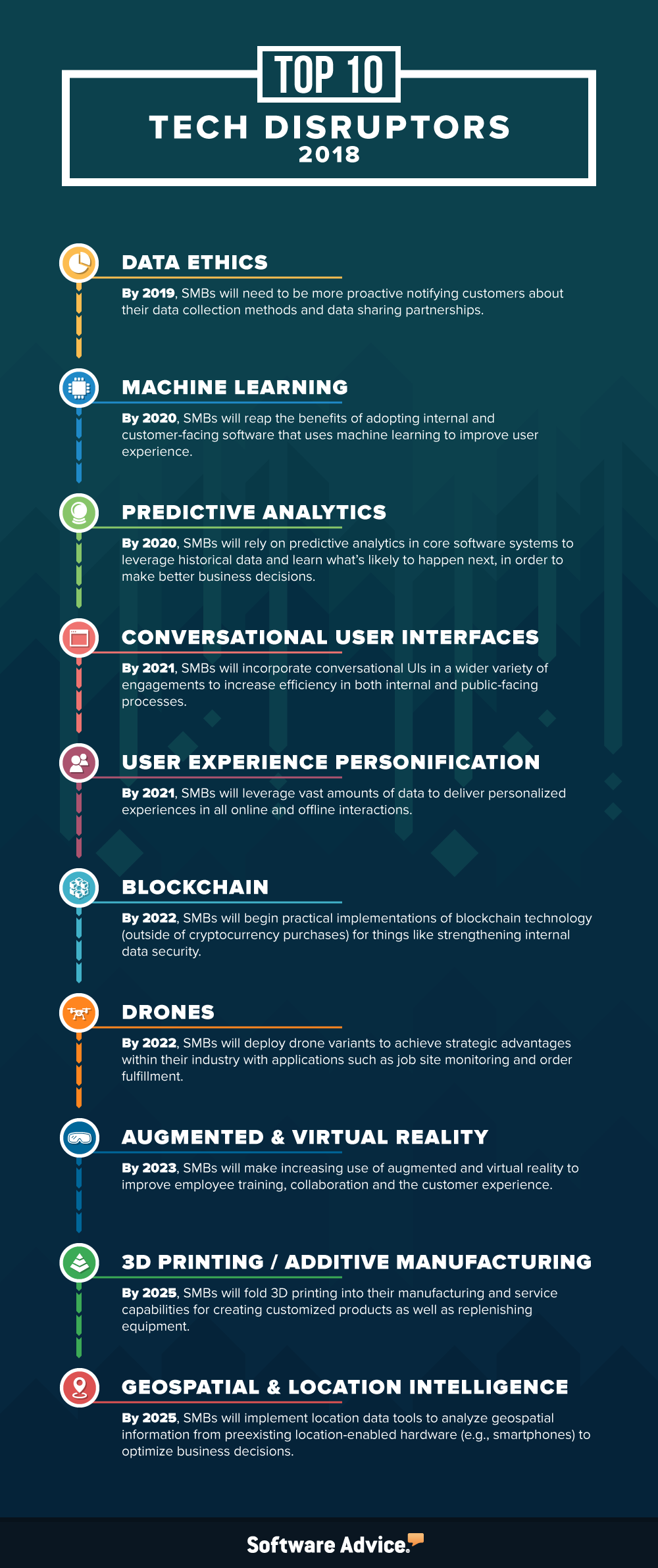
Click on a disruptor to jump to that section:
1. Data Ethics
4. Conversational User Interfaces
5. User Experience Personification
6. Blockchain
7. Drones
8. Augmented & Virtual Reality
9. 3D Printing/Additive Manufacturing
10. Geospatial & Location Intelligence
1. Data Ethics
What is the disruptor and why should SMBs care?
Unlike the other entries on this list, data ethics isn’t a new technology. In fact, it’s not really a technology at all. But this evolving group of practices used to govern how companies collect, use and disclose how they use customer data does have a significant impact on how SMBs leverage data in technology moving forward.
Think of data ethics as a finely balanced scale—on one side is the potential value to be gained from collecting and analyzing customer data; on the other is the risk of alienating your customers through the misuse (or perceived misuse) of their data.
While it may not be a true technology, the field of data ethics will be every bit as disruptive as those mentioned in this article. Consumers are increasingly wary of data collection practices and are easily spooked when companies seem to glean too much insight into their lives.

Facebook founder Mark Zuckerberg was summoned to testify in front of Congress due to concerns with data ethics (Source)
When and where will the disruptor have the greatest impact?
Businesses of all sizes will have to adhere to data ethics best practices by 2019.
Data ethics is already having an impact, though it’s difficult to measure. After a year in which questions about data ethics made some of the biggest headlines (a la Facebook and Cambridge Analytica) and Europe enacted new GDPR laws, the time for companies to start thinking differently about how they collect and use user data is now.
Data ethics will have the greatest impact in the social media arena. Social media is where a majority of consumer data is collected, and the first place most consumers turn when they want to complain about a company’s unethical use of data. SMBs that conduct any element of business on social media should act and respond with caution when questions of ethical data use come up, especially regarding invasive marketing tactics.
Companies that primarily use their own transactional data about customers have the least to worry about. However, if they sell that data to third parties or combine it with external datasets, they risk a backlash. Companies in industries that need to quantify customer behavior, like insurance, finance and healthcare, face the greatest risk of using, and being accused of using, data unethically.
How can SMBs prepare now for the disruption?
While SMBs should think of data ethics as a component of their PR or brand management strategies, internal discussions need to involve all departments that handle customer data. Much like creating a customer-first culture, creating a culture of ethical data use should be a company-wide effort.
SMBs should clearly communicate their data usage policies to customers at the moment when that data is collected. This could be done via a disclaimer in an agreement or a dedicated webpage. Just make sure your policies are easy to read and understand (and aren’t obnoxiously lengthy).
SMBs that identify their data ethics policies now—and proactively communicate them—will stay ahead of their competition. They’ll get the benefits of customer data analytics without tipping the scale too far.
2. Machine Learning
What is the disruptor and why should SMBs care?
Machine learning is a behind-the-schemes disruptor. It’s a new approach to computing that will power and improve other disruptors on this list, such as user experience (UX) personalization and conversational user interfaces (UIs).
In traditional computing, engineers hard code the logic of the software and then feed it data. The software then applies the preprogrammed logic to the data and delivers the results. A financial reporting system, for example, knows how to turn raw sales data into formalized statements because it applies the same preprogramed logic to each dataset every time.
With machine learning computing, engineers help define what the results should look like and then the algorithm (the “machine”) designs its own logic to best arrive at them. It’s a fundamentally different approach to computing.

Machine learning is the algorithm in the center of this illustration (Source)
SMBs need to understand the basics of machine learning because the odds of getting duped by a vendor that says their product has machine learning, when it really doesn’t, will only increase as more software systems are built targeting the SMB space.
Without basic knowledge, you run the risk of investing a lot of money in a system that won’t fulfill what machine learning promises: process efficiency gains and an improved user experience.
When and where will the disruptor have the greatest impact?
True machine learning will become an integral part of internal and customer-facing SMB software systems by 2020.
Machine learning is already deployed in large enterprises, most notably in the finance, healthcare and telecommunications industries. In these instances, the implementations are designed by teams of engineers working with very large datasets. Large datasets will continue to be a prerequisite for most machine learning initiatives.
Should SMBs have a large enough dataset to inform a machine learning algorithm, they’ll reap the benefits over their competitors: using sales data to provide more personalized purchase recommendations, cost figures to create more optimized budgets and production numbers to improve supply chain efficiency.
According to a 2016 report titled, “How Data Science Teams Leverage Advanced Analytics” (available to Gartner clients), the most common business functions supported by machine learning include:
Customer marketing
Strategic and financial planning
Sales
Risk and fraud compliance
Product development
Customer service
How can SMBs prepare now for the disruption?
When talking about up-and-coming technologies—especially ones that sound more futuristic, like machine learning—many companies want to take a wait-and-see approach. Others want to get in early and reach for the first products that offer solutions to address their business challenges. The best approach, however, lies somewhere in the middle.
Make no mistake: machine learning will have an immense impact on how businesses compete and which come out ahead in the marketplace. And while it will take a few more years before more widely deployable machine learning applications trickle down from larger companies to smaller ones, SMBs can and should prepare for them today.
As we’ve explained in previous reports, the best way to prepare for new technologies is to adopt the technologies of today. (These refer to CRM and customer service platforms, retail systems, project management tools and the like.) Integrating these tools into your day-to-day business activities will help grow and organize the database that you’ll use to better leverage the machine learning tools of tomorrow.
3. Predictive Analytics
What is the disruptor and why should SMBs care?
The broad question of “What’s going to happen next?” has plagued businesses since the beginning of commerce itself. The company that can predict the future better than its competition is more adequately prepared to anticipate change, adjust their strategy and succeed.
With predictive analytics, SMBs finally have the means to be proactive, rather than reactive. Using statistical techniques such as regression analysis, forecasting, multivariate statistics and pattern matching, predictive analytics capabilities found in a growing number of business software systems can analyze SMBs’ vast stores of historical data to calculate what’s likely to happen with that data moving forward.
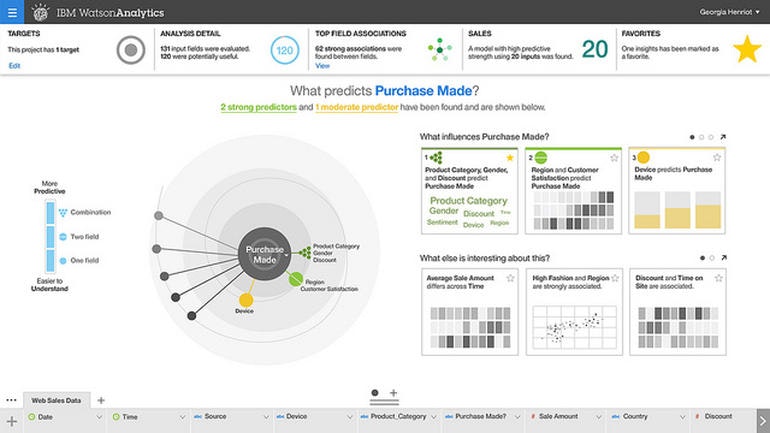
Predicting customer purchase behavior in IBM Watson Analytics (Source)
Gartner explains why every business should care about this evolution in the report “Combine Predictive and Prescriptive Analytics to Drive High-Impact Decisions” (available to Gartner clients):
“To make sound decisions, organizations need to assess, quickly and accurately, complicated and time-sensitive matters … They must make decisions based on likelihoods, such as what is likely to be the optimal price, the right marketing mix, the best route or the most suitable time to schedule maintenance. [Predictive analytics] offers a way for organizations to shape a future that looks uncertain.”
When and where will the disruptor have the greatest impact?
Predictive analytics will disrupt SMB decision-making in all industries and work functions by 2020.
Predictive analytics is nothing new—financial institutions have been using it to calculate those pesky credit scores for decades. The difference today is that you no longer need to be a massive enterprise with a data scientist on the payroll to do it, thanks to the growing popularity of user-friendly analytics capabilities in business software products.
As analytics capabilities trickle down to the SMB space, this will have wide-reaching implications for a number of industries and roles:
HR departments can use historical employee performance and attrition data to predict which workers are most likely to leave or be worthy of a promotion.
Manufacturers can use old maintenance reports to predict the likelihood that a piece of machinery will fail and put together a plan based on a range of possible outcomes.
Retailers can use past sales trends and behaviors to predict purchase likelihood, churn risk and a number of other important metrics for individual customers.
There’s just one obstacle left to predictive analytics becoming a mainstay in SMB management: software adoption. According to a survey conducted by Wakefield Research and Concur, 84 percent of SMBs still rely on manual processes.
As more and more small businesses join the 21st century and replace manual methods with dedicated systems for core processes, the widespread use of predictive analytics to solve business challenges will follow.
How can SMBs prepare now for the disruption?
The accuracy of predictive analytics lies entirely in the accuracy of an SMB’s historical data—which means this is something you should be concerned with now.
Here are steps that SMBs can take to prepare for predictive analytics:
Have a centralized database in place to securely house historical data for things like sales, product inventory and employee performance, and implement processes to clean that data regularly. (We show you how to do this with Microsoft Excel here.)
Eliminate statistical noise by determining which data sources and datasets are worthy of predictive analysis (e.g., sales figures) and which ones have little or no bearing on business outcomes (e.g., employee attendance data).
Talk to software vendors to determine the strength of the analytics capabilities in their core platforms. How customizable are dashboards and reports? Does the vendor offer any data prepping services? If they don’t have analytics capabilities, figure out their timeline for implementation.
4. Conversational User Interfaces
What is the disruptor and why should SMBs care?
Conversational user interfaces are a collection of technologies that help guide users through digital interactions. Examples include chatbots and virtual assistants. These technologies can be deployed externally (e.g., in customer service contexts) or internally to improve employee workflows.
In customer service contexts, conversational user interfaces have several benefits. They can:
Improve the customer experience by quickly providing the right information.
Improve online engagement by offering the correct online materials to the right customers.
Increase online conversions by lowering the barrier to first contact.
Used internally, conversational user interfaces make employees’ jobs easier. Take employee onboarding, for example. Instead of dedicating an HR person to sit through this mandatory process, a conversational user interface in software could walk new hires through paperwork and answer any questions they have instead, pulling answers from a centralized knowledge base.
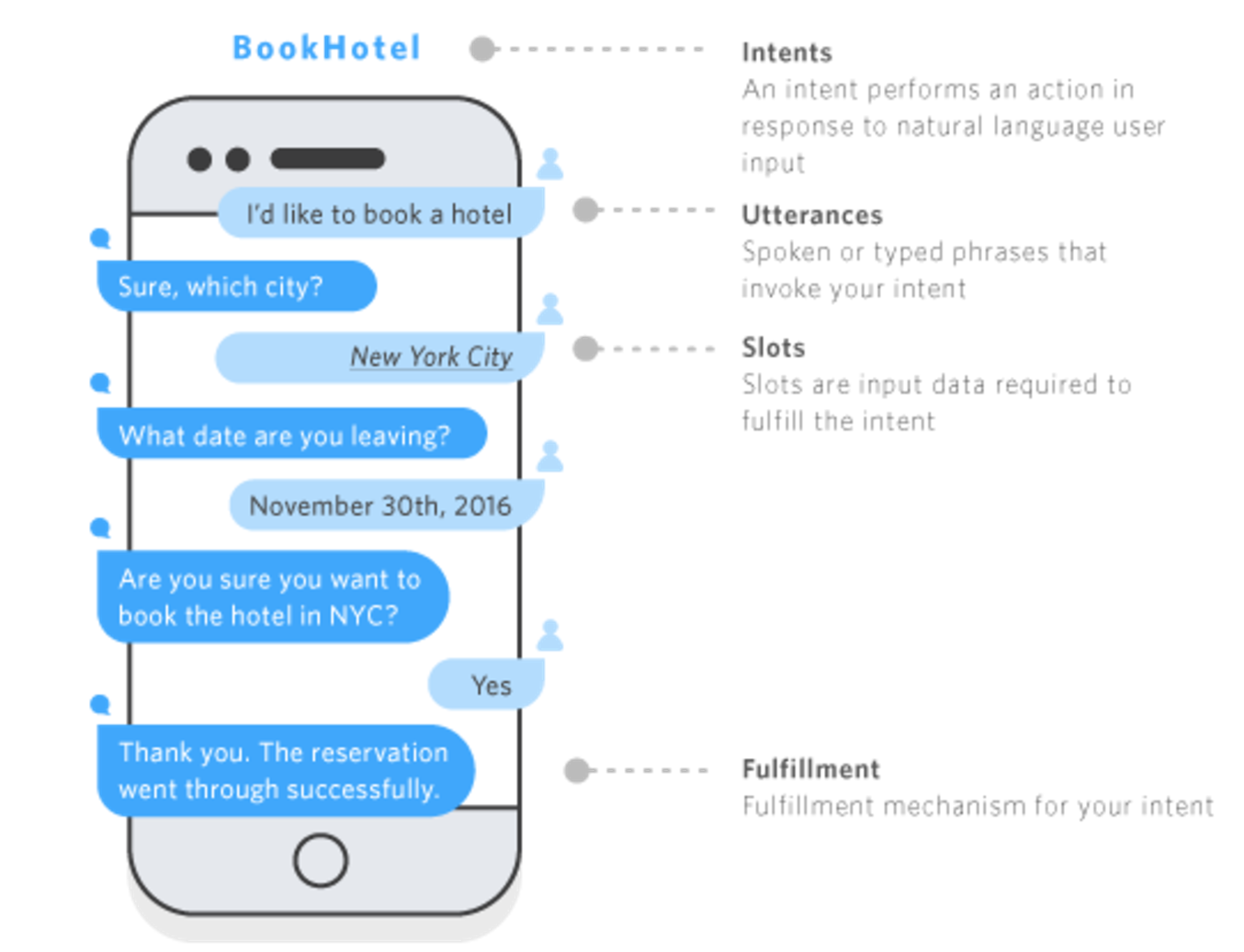
Example of a mobile conversational UI (Source)
When and where will the disruptor have the greatest impact?
SMBs will incorporate conversational UIs in a wider variety of interactions to increase efficiency in both internal and public-facing processes by 2021.
Conversational user interfaces for customers are already at work on some SMB websites. They can be seen in their most primitive form on online self-help customer service pages, where, for example, they ask visitors a series of questions to guide them to the correct answer or article. This implementation is most commonly used by SMBs with technical products, like consumer electronics and online software.
Chatbots are an increasingly common form of conversational user interface. They’re often deployed on SMB website landing pages to answer basic questions (e.g., “What are your store hours?”). They can also gather basic information about a customer’s needs or problems as the first step to help determine which employee or department will pick up the conversation via live chat.
How can SMBs prepare now for the disruption?
In the most likely scenario, SMBs will adopt conversational user interfaces as an automated solution to pre-existing customer and employee experience improvement initiatives. These lower level initiatives are the best and easiest way for SMBs to prepare for this disruption. Examples of these initiatives can include:
An internal knowledge management system that centralizes company information and makes it easy for employees to find.
A live chat application for communicating with customers online, which can later be transitioned into a partly automated conversational user interface with use of a chatbot application.
5. User Experience Personification
What is the disruptor and why should SMBs care?
Business leaders, especially those in digital marketing roles, are constantly deploying strategies to offer more personalized experiences. Greater personalization positively affects consumer behavior, influencing their buying decisions.
However, personalization tactics have come under scrutiny in recent years with worries around personally identifiable information (PII): any combination of information that can lead to the identification of a person, such as age, date of birth, address etc.
To overcome the scrutiny surrounding PII, businesses have pivoted to personification-based experiences. Here’s the difference between the two:
“When Sarah visits Sephora online, the makeup and beauty site helps her pick the perfect shade from more than a hundred skin tones, thanks to her unique profile in its Beauty Insider rewards program. That’s personalization,” explains Andrew Frank, Gartner vice president and distinguished analyst.
Personification is when Sarah, who loves snowboarding, purchases a GoPro after learning about it from targeted Facebook ad. GoPro didn’t need one-to-one personalization to find Sarah and recommend their product. They used personification to target all Facebook users interested in snowboarding, since their data identifies snowboarders as ideal customers.
This ability to “personalize” by targeting the traits of certain groups allows businesses to influence consumer behaviors—particularly in regard to user experience design—without the worry of being too intrusive.

Personification ads like this one for Porter Road can target Facebook users that follow chefs, restaurants, farms and other food-related pages to increase the likelihood of a click or conversion.
Personification is easy to scale because it can make assumptions and recommend optimal actions using persona information. Personalization tactics, on the other hand, require loads of individual information to make the same assumptions and recommended actions.
When and where will the disruptor have the greatest impact?
UX personification will disrupt SMB-designed personal experiences in all industries by 2021.
We’re already seeing user data being utilized to create more personalized experiences. Digital footprints will continue to grow for consumers, and as platforms like Facebook and Twitter continue gaining more users, businesses will continue targeting valuable personas with specialized marketing content.
Consumer-facing businesses must adopt personification marketing and experience strategies to grow their business. But SMBs face a great challenge here in competing against enterprise organizations with seemingly unlimited resources.
To counter this, SMBs using personification should focus on more niche markets. For example, SMBs wouldn’t just target Sarah with a GoPro ad because she’s into snowboarding—they would only target her if she was also into videography. This is a smaller pond, but it should also be less competitive.
How can SMBs prepare for the disruption?
Leveraging persona information will require SMBs to adopt advanced data analytics tools. These tools will become more readily available for SMBs in years to come. For now, steps SMBs can take to stay in front of this disruption include:
Adopting a new customer relationship management (CRM) system to start recording customer interactions, if you haven’t done so already.
Studying use cases to find businesses (of all sizes) in your market that are successfully using personification.
6. Blockchain
What is the disruptor and why should SMBs care?
It’s safe to say that if grandma knows what bitcoin is, it’s kind of a big deal. While day traders and mainstream media outlets are busy riding the ups and downs of the current cryptocurrency wave though, software developers are focusing on the possibilities of the underlying technology that powers its existence: blockchain.
Blockchain is a type of decentralized accounting ledger where data transactions are linked together, then recorded across a public peer-to-peer network. If you can imagine a world where you don’t need a bank to have a savings account or a notary to make a contract legally binding, you’re imagining a world running on blockchain.
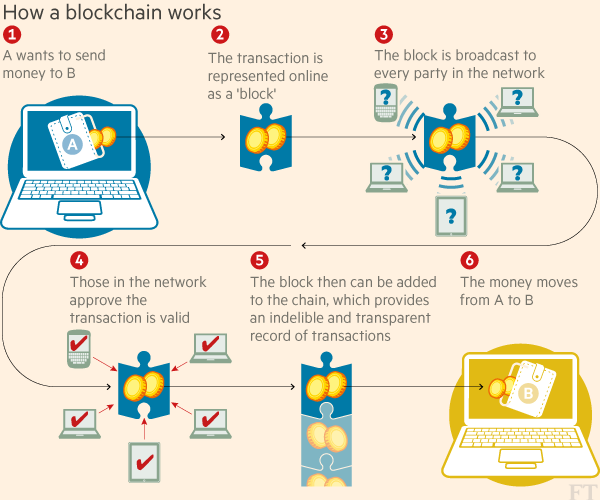
How blockchain works (Source)
Bitcoin is the most recognizable application of blockchain today, but this more secure, more transparent, more easily authenticated method of data ownership and transference has the potential to disrupt everything for SMBs in the future. Gartner explains in their report “Top 10 Strategic Technology Trends for 2018: Blockchain” (available to Gartner clients):
“Blockchain reduces friction from transactions across the business ecosystem, potentially lowering costs, reducing transaction settlement times and improving cash flow. Assets can be traced to their origin, significantly reducing the opportunities for substitutions with counterfeit goods.”
When and where will the disruptor have the greatest impact?
SMBs will begin practical implementations of blockchain technology outside of cryptocurrency purchases by 2022.
To cover all of the potential applications of blockchain technology, we’d need a whole separate report (Gartner recognizes over 20 possible use cases in industries as disparate as music streaming, ride-sharing and academia).
Here are just a few examples of businesses that will be significantly impacted:
Hospitals will use patient records powered by blockchain to ensure patient information is accurate, up-to-date and not tampered with hopping around from provider to provider.
Retailers worried about the quality of their products will leverage blockchain to guarantee that every partner in their supply chain are meeting defined standards.
Instead of running background checks and contacting previous employers, recruiters will use applications submitted via blockchain to automatically verify candidate information.
Realtors and lawyers (i.e., paper-heavy professions) will use blockchain to digitize records and validate their legitimacy without needing a legal intermediary.
A majority of blockchain projects will fail to get out of the proof-of-concept phase, and many enterprises will struggle to produce a positive ROI with the ones that are left: According to Gartner, by 2020, 80 percent of blockchain-based initiatives that are designed to save money will fail to do so.
Despite these challenges, they’re not about to give up. With over $4.5 billion invested in blockchain, big businesses will soon overcome hurdles like reducing the computational power required to process blockchains, generate greater buy-in and ROI, and implement it successfully. SMBs will benefit soon thereafter.
How can SMBs prepare now for the disruption?
The challenge with blockchain isn’t figuring out where to apply it—it’s learning where you don’t need to. According to Gartner, 85 percent of projects through 2018 with “blockchain” in their titles will deliver business value without actually using blockchain.
Here’s how SMBs can prepare to turn blockchain hype into reality:
Learn more about all of the possible benefits blockchain could bring to specific processes, and pick one or two you want to achieve through implementation.
Stay up-to-date on the latest vendors entering the blockchain space. Your business isn’t likely to develop their own blockchain tools, so you’ll need to look externally.
Calculate a rough estimation for the highest cost your SMB can stomach with a desired blockchain project application to figure out a timeline for consideration.
7. Drones
What is the disruptor and why should SMBs care?
Drones possess seemingly limitless potential. We’re seeing more and more construction companies adopt drones to monitor their job sites. And Amazon “has some ideas” for drones that will disrupt at least the transportation and delivery of goods, if not more.

Amazon has plans in place for automated drones to deliver packages (Source)
According to the Gartner report “Predicts 2017: Drones”:
“Drones continue to gain more acceptance in enterprise, and some companies already have fleets of drones being deployed for industrial inspection, surveillance, mapping and other applications.”
While drones are obviously not applicable to every type of business, they have more uses than you probably think. And they offer immense value for the businesses that use them.
The construction industry is a great example of drones’ disruptive potential.
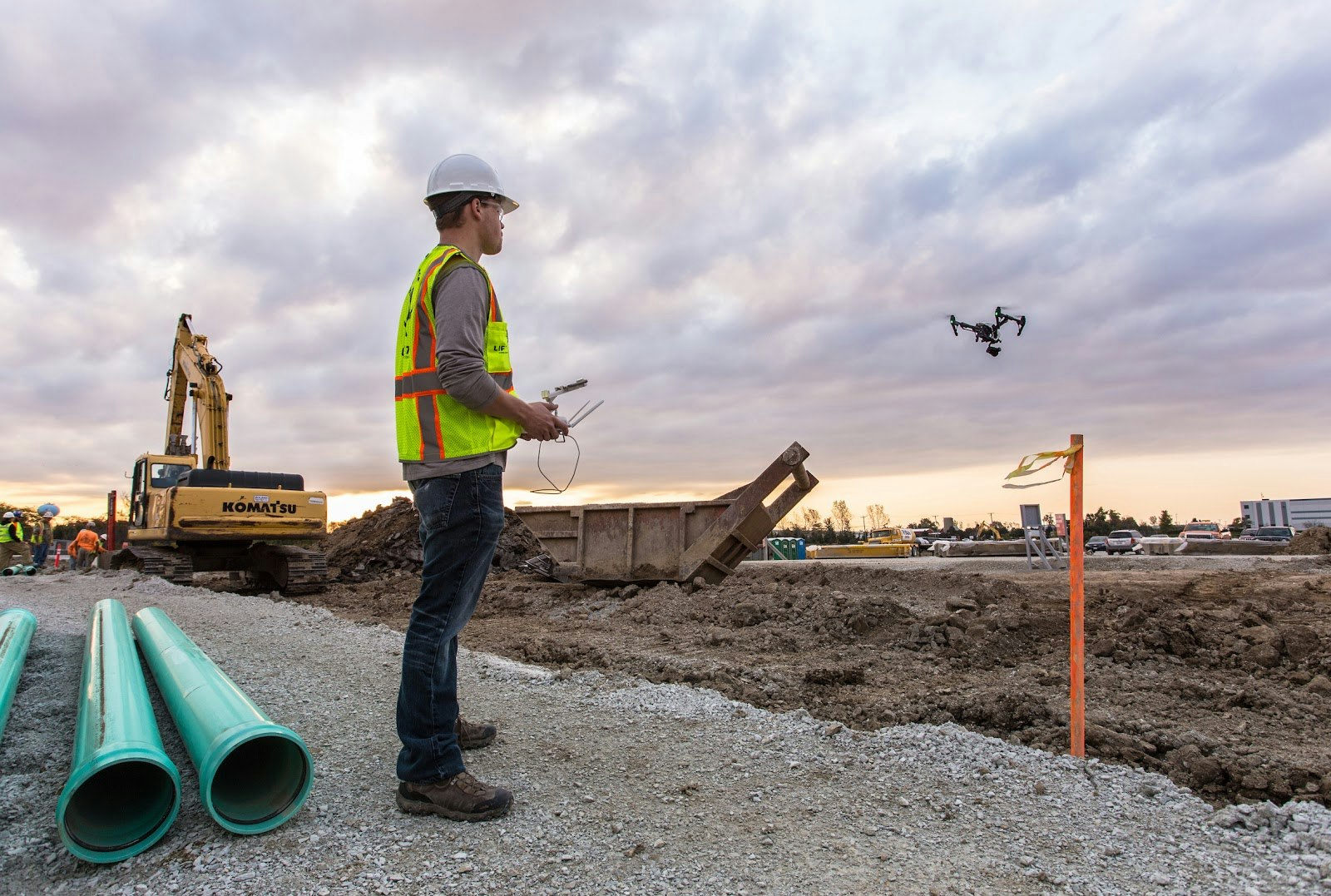
Drones offer newfound efficiency for construction job site (Source)
Drones can complete tasks such as land surveying and job site mapping quicker, safer and cheaper than humans ever could. Specific capabilities include conducting electronic measurements of land distance, taking high resolution images over an extended period of time and working as a mobile sensor that can monitor employees and send and receive valuable information gathered from/for field technicians.
The delivery space is another industry that drones will disrupt. We’ve already mentioned Amazon and their disruptive drone strategy. These flying devices, especially when automated, can theoretically move any kind of products over short distances faster than traditional roads.
Drones open the door for same-day delivery, allowing businesses to send and receive/sell and restock products more rapidly than ever before. Amazon’s Prime Air suggests 30 minute delivery times are eventually possible all across the globe once they build out their infrastructure. And UPS has tested drone delivering packages from their delivery vans to customer doorsteps. Once these giant enterprises deploy their drone delivery strategy, we’ll see many more businesses follow suit.
When and where will the disruptor have the greatest impact?
Business will deploy drone variants to achieve strategic advantages within their industry by 2022.
Drone technology and capabilities are increasing exponentially. Paired with ever-improving artificial intelligence, drones will soon be able to fly without human operators.
We’re already seeing them used in construction and delivery. Adoption here will continue increasing as more and more organizations realize the benefits, and as more and more vendors offer increasingly accessible drone options.
Plenty of other industries should also see drone adoption soon. Farming and agriculture businesses will benefit from drones monitoring crops and livestock. And all levels of government (e.g., local, city, state, federal) can benefit from drones in multiple sectors (e.g., police/firefighters, national parks, waste management).
How can SMBs prepare now for the disruption?
For SMBs to get serious about drones, start by figuring out the value-add drones will provide. This will allow you to see where to invest in order to actually take advantage of the drone disruption. Typical investments include:
Updating foundational software, such as inventory management and customer relationship management (CRM) systems, so drone software can pull from this data to inform and optimize drone activity.
Optimizing processes to account for drone integrations, and determining the extent to which current processes need to be adjusted once drones take over certain tasks.
Hiring or consulting with drone experts that specialize in adhering to FAA regulations, machine mechanical maintenance and other highly technical, highly specific protocols.
8. Augmented & Virtual Reality
What is the disruptor and why should SMBs care?
Ask anyone what comes to mind when they think of augmented reality (AR) or virtual reality (VR), and you’ll likely hear one answer more often than the rest: cheap thrills.
That’s not an accident. AR/VR started in bulky machines in the back of 1980s arcades. It’s since evolved into sleeker, more accessible home entertainment headsets like the Oculus Rift and HTC Vive and even Snapchat’s animated lenses. Still, though, the predominant use case has always been to provide a more immersive entertainment experience than users have ever encountered before (just look at the wildly popular Pokemon Go).
Being able to mesh a view of the physical world with a computer-generated one has far more practical implications beyond fun though, and SMBs should be paying attention. Organizations can use AR and VR to provide all types of users (e.g., employees, customers) with the ability to interpret real-time information, experience virtual environments and socially collaborate beyond the confines of a smartphone or computer screen.
For example, Lowe’s Home Improvement stores have used AR to create an in-store map that customers can use to find the exact products they’re looking for.
Example of Lowe’s in-store navigation
Now with the release of development kits for Apple and Google operating systems (ARKit for iOS and Google’s ARCore for Android), SMBs will see a wave of AR/VR applications relevant to their industry. Pretty soon, you’ll be able to train technicians on AC repairs by having them work on a simulated replica. Or, you’ll be able to walk through a space you might book for an event you’re planning—all without leaving the comfort of your couch. That’s a disruptor.
When and where will the disruptor have the greatest impact?
AR and VR will disrupt SMBs in industries such as construction, field service, hospitality, healthcare, manufacturing and retail by 2023.
In the report “Top 10 Strategic Technology Trends for 2017: Virtual Reality and Augmented Reality” (available to Gartner clients), Gartner outlines four key areas where AR and VR will play a significant role:
Area | Example |
Training and education | Immersive situational training for doctors and police; simulated use of heavy machinery for manufacturers. |
Design, collaboration and development | The ability to visualize schematics during construction for home builders; real-time space planning for facilities managers. |
Repair and maintenance | “See-what-I see” cameras for remote workers seeking guidance from HQ; augmented displays for microsurgeons. |
Engagement and customer experience | Virtual travel experiences for resorts; product visualization and “try-on” scenarios for customers at various retailers. |
Premium VR hardware is still very expensive (high-quality headsets can cost up to $2,000) and virtual reality sickness is still a largely unresolved issue. But AR applications will continue debuting and ramping up use cases, inspiring SMBs to get on board.
How can SMBs prepare for the disruption?
According to Gartner, AR applications on mobile devices will be adopted in 30 percent of large enterprises as part of their digital transformation strategy by 2020. While your larger brethren ramp up to deployment, here are a few steps you can take to prepare:
Come up with novel ways that AR and VR can enhance customer experiences or operational process (e.g., employee training) within your business.
Tie AR and VR projects to desired organizational objectives and goals (e.g., revenue, proficiency or customer service).
Stay up to date with AR and VR use cases in your industry and try opening lines of communication with vendors and app developers to learn about possibilities and test prototypes.
9. 3D Printing/Additive Manufacturing
What is the disruptor and why should SMB businesses care?
Organizations across all types of industries are using 3D printing to turn digital designs into physical products. This technology enables the intricate and accurate physical creation of computer-aided design (CAD) templates—physical creations that cannot be manufactured with any other technology.
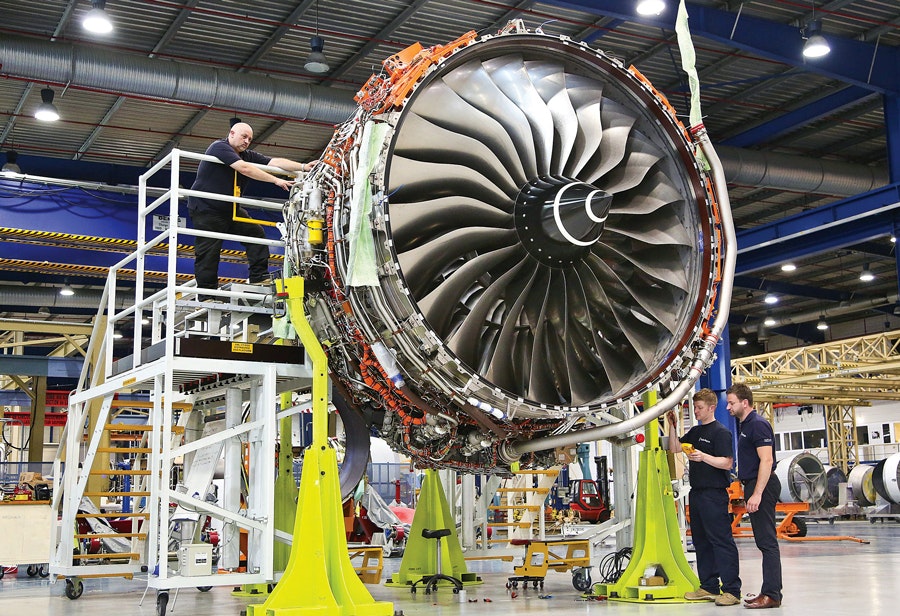
Rolls-Royce Trent XWB-97 engine made with 3D printed parts (Source)
The term “additive manufacturing” refers the to 3D printing process of adding layers upon layers of building material to create a finished product.
According to Harvard Business Review, the main advantage of additive manufacturing technology is that it can manufacture pieces in a single print. Normally, pieces have to be molded, printed/pressed and then assembled.
Current 3D printing isn’t (and may never be) as efficient as other manufacturing methods for simpler production, such as repetitively pressing metal sheets into the same simple shapes. But again, 3D printing makes it possible for businesses to create previously impossible to make products.
One such impossibility 3D printing overcomes is the ability for greater customization in one-off manufactured products. Previously, customizations were impossible because they would require a full run, rather a spinoff, of the original product. With 3D printing, every product is built from scratch. Customizations only need to be added into the digital design of the printed product.
Customization offers an interesting business model for retailers—essentially merging store and manufacturer into one operation. This model is similar a custom T-shirt store, only instead of a blank T-shirt as the canvas, 3D printing allows businesses to start at the string level and create the T-shirt while also imparting the print.
Apply this T-shirt example to auto parts and metal printing or on-location tool manufacturing, and you can start to see the disruption these systems can create.
When and where will the disruptor have the greatest impact?
SMBs will incorporate 3D printing into their manufacturing and service processes for creating customized products as well as replenishing equipment by 2025.
Additive manufacturing will continue to disrupt the manufacturing industry. As it applies to SMBs, this will have a ripple effect that trickles down to supply chains and warehouses, consumer packaged goods and retailers and numerous other specialized industries, such as field service and medical, that rely on unique, one-off tools.
3D printing also has the potential to make manufacturing increasingly local because new businesses can invest in 3D printers to produce goods, rather than having them produced elsewhere. This cuts down on shipping and warehousing costs and allows businesses to buy/stock local products for nearly anything.
How can SMBs prepare for the disruption?
Determine how 3D printing and additive manufacturing can improve your operational processes and/or stretch your bottom line. See if you can lower expenses over the long-term by owning the manufacturing of materials, tools and products. Of course, this will require a significant investment in the short term, which you’ll have to plan for.
Steps SMBs can take to prepare for this disruption include:
Open lines of communication with your supplier’s manufacturers to see where they stand on investing in 3D printing.
Review additive manufacturing use cases to determine the prevalence and practicality of 3D printing for businesses like yours.
Reach out to local/state universities to see if they have 3D printers in use for research. If so, consider setting up a partnership to test the viability of 3D printing products/parts/ tools for your business.
10. Geospatial & Location Intelligence
What is the disruptor and why should SMB businesses care?
Geospatial and location intelligence is the use of strategically placed sensors for tracking consumer/employee movement. Sensor-based technology gathers and analyzes location-based data from smartphones and other Internet of Things (IoT) devices. The sensors send and receive data to and from these devices using various channels, such as Bluetooth, WiFi and RFID (radio-frequency identification).
Businesses can use location-based data to analyze movement throughout a location and potentially spot trends and drive new behaviors.
For example, if you can track movement throughout a store, you can pinpoint high-traffic areas and place more expensive items there in an attempt to increase average transaction amounts.
![]()
Malls can serve customers different ads depending on what store they enter (Source)
But the uses extend into industries beyond retail. For example, a construction company could look at how their on-site staff moves around throughout the day and position tools and building materials strategically to make them more easily accessible.
The sensor technology driving geospatial intelligence has been around for some time, and is relatively inexpensive.
According to Gartner’s report “Hype Cycle for Business Intelligence and Analytics, 2016″ (available to Gartner clients):
“Analyzing business data in the context of location can uncover spatial trends, dependencies and patterns that are otherwise undetectable. Greater adoption, broader utilization, and new technologies and services will be driven by the Internet of Things (IoT).”
Recording human movements and interactions using this type of technology provides a huge amount of data that businesses can analyze and use to optimize their processes and experiences.
When and where will the disruptor have the greatest impact?
SMBs will implement location data tools to analyze geospatial information from preexisting location-enabled hardware (e.g., smartphones) to optimize business decisions by 2025.
Geolocation sensor technology has existed for sometime, as with Apple’s 2013 release of the iBeacon.
The difficulty SMBs face is how to apply the findings from analyzing location-based data in a way that makes sense for their business and creates positive change. But if businesses can find a way to apply this data in meaningful ways, they can essentially conduct optimal movement throughout their operation.
How can SMBs prepare for the disruption?
There are already many location-based sensor and analytics technologies in the marketplace. Along with adopting and installing the physical sensors necessary for this tech to work, SMBs must be prepared to house and analyze the data gathered from these sensors so it can be turned into meaningful recommendations.
Steps SMBs can take to stay in front of this disruption include:
Set aside the resources (e.g.,money, expertise) necessary to properly install the physical sensor hardware and the software needed to analyze the data gathered.
Optimize or adopt a new customer relationship management (CRM) system that will help tie personalized location data to specific customers so their experiences can be positively impacted.
Assign or hire champions that can dedicate time analyzing the location-based data and interpreting the findings into actions for the business to take.
Next Steps
It’s fun for us to research and project the timing of all this exciting technology. We’ll get some things correct while others might not pan out. However, there’s one thing we know for certain year after year:
Small businesses that haven’t invested in a solid software foundation will miss out on competitive advantages once these disruptors hit the market.
You must keep in mind how crucial previously collected and cleaned data is for any of these disruptors—be it customer, employee or other performance metrics, data is the fuel powering these disruptors.
With that in mind, here are some next steps you should take to ensure you’re ready to take full advantage of these coming disruptors:
We mention customer relationship management (CRM) software in many of the sections above. If you don’t have a CRM in place, that’s a great place to start.
If you don’t need CRM software, then head to softwareadvice.com. There, you can learn more about different types of business software for your company’s specific industry needs, and compare top-rated products.
Call (855) 998-8505 to get connected with one of our expert software advisors. They’ll learn about your unique needs and recommend the best products to manage and grow your business.